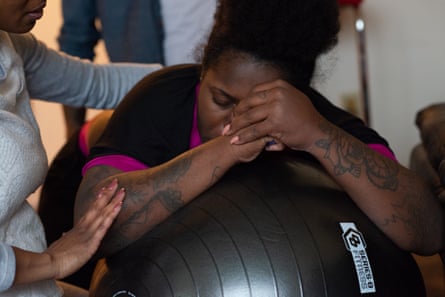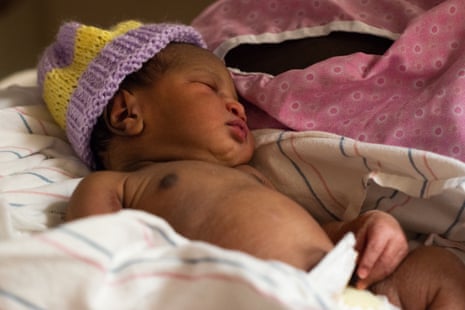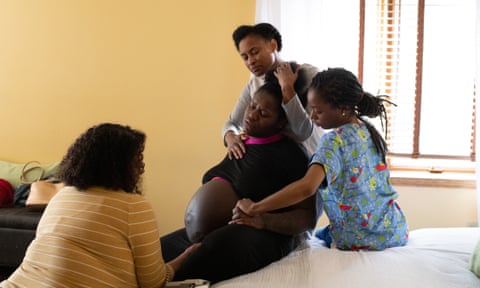Vicky Mckinney-Wigley knew Rebecca Polston was the right person to care for her and the fetus growing inside her as soon as she met her. Polston had a warm way of listening, a location in the neighborhood, and the ability to take health insurance. And, importantly for Mckinney-Wigley, Polston is Minnesota’s only black-identifying certified professional midwife.
Mckinney-Wigley, a 23-year-old African American gas station employee 31 weeks pregnant with her first baby, never felt comfortable with the doctors she saw in early pregnancy. “It just seemed like they really didn’t care what was going on with me. I couldn’t hold anything down; I couldn’t eat. My mental health was waning.”
“They never asked me how are you. How are you doing? They’d be like ‘How’s the baby?’ First question Rebecca asked me is, ‘How are you feeling? How are you feeling about yourself?’ And that just showed me that she really cared about me as a person. Not only as a host body for the baby. My stress just totally went away. I was able to eat, I was able to hold food down.”
The stakes here are high: African American babies in Minnesota are twice as likely as white babies to die in their first year.
Alexander labors near her home with the support of her mother, Tulani Alexander. Polston suggested she go for a walk so her labor could progress more before admission to the birth center
The University of Minnesota researchers Rachel Hardeman and Katy Kozhimannil are working with Polston to prove that culturally focused maternity care leads to better outcomes for black mothers, who face a maternal mortality rate more than three times that of white women. And disparities persist across income, education and social groups.
Located in Minneapolis’s Webber-Camden neighborhood, Roots Community birth center is Minnesota’s only black-owned and operated facility of its kind. Its goal is to address the reasons African American mothers are at greater risk during pregnancy and birth: stress, systemic racism, lower-quality care and underlying health issues.
Hardeman explains: “Culturally focused care sees people for who they are, what their lived experience is, and what that means for bringing a child into the world. It’s care that builds a relationship from the moment the family walks in the door.” The patients at this birth center come from a wide range of backgrounds, with 50% African American clients.
And it appears to be working: the birth center had no preterm births among its African American clients in 2017, and a primary caesarean rate of 3%.

Em’Mae labors at home with the support of her partner, Kemany Novell, and her mother, Tulani.
Hardeman and Kozhimannil are documenting the birth center’s model, with its hour-long prenatal appointments, postpartum home visits and core belief that culture is not pathology. The birth center’s staff see pregnancy as an emotional process as well as a physical one.
Polston explains: “There’s more respect, there’s more consent. I need to ask before I touch someone, every single time. It doesn’t matter if a head’s coming out of them. You can’t just stick your fingers in someone’s vagina!”
In contrast, Mckinney-Wigley says her previous clinic drug tested her at her first appointment and threatened to take her baby if she didn’t have a clean result, an experience that she hasn’t heard about from the white women she knows who have used the clinic. “I tried to figure out what could’ve possibly caused that,” she wondered. “It is the health insurance? No. We all have the same health insurance. Is it because I’m black? I felt like I was discriminated against. The fact that you threatened my child … it made me really sad. I didn’t want to go to that doctor again.”
Em’mae Alexander, 20, left her previous doctor, too. “They weren’t hearing my concerns. The nurses said, ‘Oh, I love your hair, I love your shoes.’ I appreciate trying to connect, but I’m here for my baby and I had concerns and I at least would want you to address those concerns first. Just telling me to think positive thoughts and to blow it off is not helping me.

Alexander is transferred from Roots Community birth center to North Memorial Health hospital by ambulance. Polston had begun hearing decelerations that concerned her.
“I got to the point to where I was like, I don’t want to go to any more prenatal visits. They’re not helpful. I’ll just take my prenatals, stay at home and then call you guys when I’m in labor – and I know that’s not good to do. So I was like, I have to switch to somewhere else.
“The birth center was familiar. It was in a community where I grew up in and it was more diverse. To be in that area you really have to have tough skin. I know they hear and experience stuff all day, and they’re very open to any type of culture or lifestyle. And honest, too. Honesty is the real brutal thing that can soothe a parent when I’m going through something. You can sugarcoat if you want to, but that’s not helping me.”
So the trust clients have in Polston is critical, even if they have complications and give birth elsewhere, as Alexander did – the facility isn’t able to work with breech babies, twins or certain medical conditions, though staff can attend vaginal births after caesarean (VBACs). “She offered to be the bridge between me and psychiatrists or other doctors,” says Mckinney-Wigley. “If I had to go to a hospital, she told me: ‘We can set up a meeting with a doctor that I trust so that you don’t feel like you’re just being thrown into a predicament where you don’t know this person who is going to be pulling out your baby.’”


Em’Mae Alexander labors in the tub and later at the North Memorial Health hospital.
The birth center’s clients are aware of the risks they face. “Sometimes [medical providers] feel like we might exaggerate or it’s not the truth,” explains Alexander. “I just wanted to make sure that didn’t happen to me, especially because I was experiencing the lack of concern at another hospital.”
Shawna Jackson-Haynes, a pregnant client, says: “You don’t see a lot of minorities as doctors, and with everything in this world you just don’t feel as secure as you could if somebody who looked like you was in those positions. I’ve heard stories. I have trust issues; I get them even when I go for vagina checkups. I’m so nervous, I’m thinking: ‘Oh, my God, I hope they don’t put something in me or take something out,’ and I just don’t get that here. I’m bringing a person into this world; I definitely need to be somewhere where I feel secure and I feel like I can trust who I’m working with.
“So this being a black-owned facility is really beautiful, really nice. It’s something totally different. It feels great. They’re displaying black love.”

Top left: Alexander’s friends at North Memorial Health hospital. Top right: Tulani Alexander naps briefly. Bottom: Em’Mae Alexander pushes her baby out as her mother, Tulani; the medical resident Dr Molly Gruber; Alexander’s partner, Kemany Novell, 19; and her doula, Lakesha Gordon, look on.
“Culturally, white providers are trained to pathologize people of color and to not believe them,” explains Polston. “So when people are able to be culturally intact – I don’t mean just a placeholder person of color, but someone who’s able to practice with cultural authority – they’re able to cut through that and actually care for the person.”
Though she had to transfer from the birth center to a hospital during labor, Alexander found safety and support. “It went the best it could for me. The words: it’s just mental food. The touch helped, it let me know physically that I’m not the only one going through this. I didn’t have the water birth I wanted, but I was able to be in the tub to relax my contractions and I was still able to have some delayed cord clamping. Those were the two things that were important in my birth plan that still got to happen in some way. I’m satisfied that my baby was healthy.”

Alexander holds her newborn daughter, Xhlai Nola Novell, moments after her birth.
Polston recommends pregnant people of color ask about their birth team: “Are they working to help you not be afraid? Are they telling you that you can do this? Are they excited for your baby? You have to vote with your feet: drive the extra half an hour, take the extra bus, because it will be worth it.”
Polston trains midwives with an eye toward diversifying the profession – more than 90% of nurse midwives are white. Hardeman says: “We can have many Rebeccas if we wanted to. If we can say that this model of care saves money and creates great outcomes, we should invest in it. One of the outcomes of this work is to create a toolkit that lays out step by step how you put together a culturally focused birth center.”
Polston asks: “Why do we think that increased access to racist institutions will give us a non-racist outcome? The decision to open the birth center was very specifically to provide access. I put it in north Minneapolis because I saw the strategic divestment that took place in this community – and that happens in communities all over the country. And I want to say out loud, no. We invest in black communities and we say that this is worth having.”

Hardeman and Kozhimannil seek evidence supporting this approach to share with health insurers, hospitals and policymakers. “The Affordable Care Act gave healthcare access, but it didn’t address inequities like implicit bias and structural racism. Has receiving care in this culturally-focused birth center done that?” Hardeman asks. “On a human level, we all want to feel respected, loved, powerful. Birth is such an incredible opportunity for the birthing individual to have autonomy over their body, and when you are trying to do that in a space that wasn’t created for you, you have to work that much harder to get it. Not everyone has that opportunity right now. And that breaks my heart.”
But Mckinney-Wigley did. “My first visit here, after talking to them, I cried because somebody actually cared. And that’s the biggest thing. Just knowing that you care. Not just about the wellbeing of my baby but my wellbeing.”
“It feels like a revolution is happening,” says Jackson-Haynes. “I don’t know anybody who has gone this route so hopefully people after me, like maybe my little sisters, if they have babies, will.”
This project was produced with the support of Women Photograph and the Women’s Equality Center
